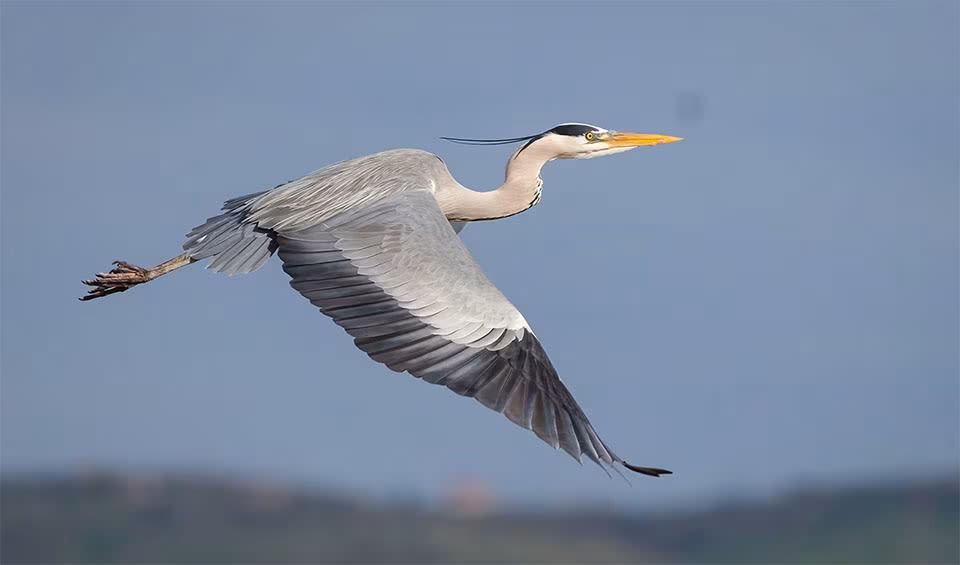A widely recognized wader, gracing a variety of aquatic landscapes with its poised stance and striking appearance. This bird is a familiar sight across temperate Europe, parts of Asia, and Africa, often found along the edges of lakes, rivers, and ponds.
Standing up to a meter tall, the Grey heron is an imposing figure with a wingspan that can reach up to 195 cm (77 inches). Its plumage is an elegant combination of slate grey on the body, with a contrasting white head and neck. During the breeding season, adults don a more ornate look with black feathers forming a striking eyestripe extending to the nape and beautiful, elongated plumes called “aigrettes” adorning their chest and back.
The Grey heron’s slender legs are perfectly adapted for wading through various water depths, while its long, sinuous neck coils into an “S” shape during flight, making it a distinctive silhouette against the sky. Its bill is sharp and powerful, ideal for spearing fish, its primary prey. However, the heron’s diet is not limited to aquatic life; it will also hunt small mammals like voles, birds, amphibians, and even insects, making it an opportunistic and versatile predator.
These birds are known for their solitary hunting habits, often standing statue-like, peering into the water to locate their next meal. When prey comes within range, the Grey heron strikes with lightning speed, its bill an effective tool for capturing and subduing its catch. Despite this apparent stillness, they are capable of quick movements when necessary.
Distribution
 Afghanistan
Afghanistan Albania
Albania Algeria
Algeria Andorra
Andorra Armenia
Armenia Australia
Australia Austria
Austria Azerbaijan
Azerbaijan Bahrain
Bahrain Bangladesh
Bangladesh Belarus
Belarus Belgium
Belgium Benin
Benin Bhutan
Bhutan Bosnia And Herz.
Bosnia And Herz. Brunei
Brunei Bulgaria
Bulgaria Burkina Faso
Burkina Faso Burundi
Burundi Cambodia
Cambodia Cameroon
Cameroon Canada
Canada Cape Verde
Cape Verde Central Af. Rep.
Central Af. Rep. Chad
Chad China
China Comoros
Comoros Croatia
Croatia Cyprus
Cyprus Czechia
Czechia DR Congo (Kinshasa)
DR Congo (Kinshasa) Denmark
Denmark Djibouti
Djibouti Egypt
Egypt Eritrea
Eritrea Estonia
Estonia Ethiopia
Ethiopia Faroe Islands
Faroe Islands Finland
Finland France
France Gabon
Gabon Gambia
Gambia Georgia
Georgia Germany
Germany Ghana
Ghana Gibraltar
Gibraltar Greece
Greece Greenland
Greenland Guam
Guam Guinea-Bissau
Guinea-Bissau Guinea
Guinea Hong Kong
Hong Kong Hungary
Hungary Iceland
Iceland India
India Iran
Iran Iraq
Iraq Ireland
Ireland Israel
Israel Italy
Italy Japan
Japan Jordan
Jordan Kazakhstan
Kazakhstan Kenya
Kenya Korea
Korea Kuwait
Kuwait Kyrgyzstan
Kyrgyzstan Laos
Laos Latvia
Latvia Lebanon
Lebanon Libya
Libya Liechtenstein
Liechtenstein Lithuania
Lithuania Luxembourg
Luxembourg Macao
Macao Malaysia
Malaysia Mali
Mali Malta
Malta Mauritania
Mauritania Mexico
Mexico Moldova
Moldova Mongolia
Mongolia Montenegro
Montenegro Morocco
Morocco Myanmar
Myanmar Nepal
Nepal Netherlands
Netherlands Niger
Niger Nigeria
Nigeria Nort. Mariana Is.
Nort. Mariana Is. North Korea
North Korea North Macedonia
North Macedonia Norway
Norway Oman
Oman Pakistan
Pakistan Palau
Palau Philippines
Philippines Poland
Poland Portugal
Portugal Qatar
Qatar Romania
Romania Russia
Russia Rwanda
Rwanda Saint Pierre
Saint Pierre San Marino
San Marino Saudi Arabia
Saudi Arabia Senegal
Senegal Serbia
Serbia Seychelles
Seychelles Sierra Leone
Sierra Leone Singapore
Singapore Slovakia
Slovakia Slovenia
Slovenia Somalia
Somalia South Sudan
South Sudan Spain
Spain Sri Lanka
Sri Lanka Sudan
Sudan Svalbard
Svalbard Sweden
Sweden Switzerland
Switzerland Syria
Syria Taiwan
Taiwan Tajikistan
Tajikistan Tanzania
Tanzania Thailand
Thailand Togo
Togo Trinidad & Tobago
Trinidad & Tobago Tunisia
Tunisia Turkmenistan
Turkmenistan Turkey
Turkey UAE
UAE Uganda
Uganda Ukraine
Ukraine United Kingdom
United Kingdom United States
United States Uzbekistan
Uzbekistan Vietnam
Vietnam Yemen
Yemen Zambia
Zambia Zimbabwe
ZimbabweAnything we've missed?
Help us improve this page by suggesting edits. Glory never dies!
Suggest an editGet to know me
Terrestrial / Aquatic
Altricial / Precocial
Polygamous / Monogamous
Dimorphic (size) / Monomorphic
Active: Diurnal / Nocturnal
Social behavior: Solitary / Pack / Herd
Diet: Carnivore / Herbivore / Omnivore / Piscivorous / Insectivore
Migratory: Yes / No
Domesticated: Yes / No
Dangerous: Yes / No




